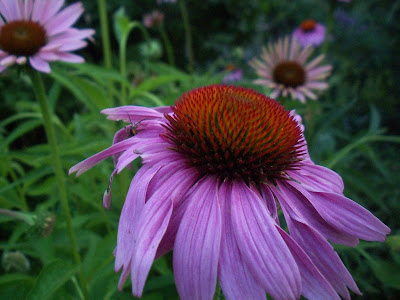Echinacea just might have been the "gateway herb"
leading to the current renaissance in herbal medicine for the people. In the late 1980's and early 1990's word of
this plant spread like wild fire, like a secret password to a special
club. I still remember the first time it
was uttered in my presence. At our
quaint little shop filled with teas, potpourris, and sweet pillows, a customer
asked for it. As was our custom back in
those days, we listened, nodded, and upon arriving home, tore into our
books. "What was it?" my sister
said, "ecky stuff... what?" It
took us a while since the internet was still wet behind the ears, but a few
books, a few phone calls, and we were on the trail.
As soon as you learn about it, you'll begin to see it everywhere. It is a very common garden plant, even when
the gardener doesn't use it for medicine.
Echinacea is a beautiful flower, and in the last 20 years many cultivars
have been bred so that the colors and form are varied and to some,
improved. For medicinal use, the old
heirlooms are what we use. Angustifolia,
purpurea, and a few other natives (for instance in Tennessee, there is a native variety with
very slim petals called tennesseensis) are the most useful. Most commercial preparations use purpurea, but
for home use we don't differentiate too much.
Ours here on the farm has crossbred quite a bit. It all seems to work for us just fine.
Over the years Echinacea has been proven, disproven, and
proven again. Studies have been done
that show it works to boost and support the immune system, and others that show
it does not. If you ask any herbalist or
herb enthusiast who has used Echinacea though, you will hear that it does in
fact work. It must be taken at the very
first sign of a viral assault, be it a scratch in the throat or an achy arm
muscle (my own tip-off). It must be
taken early, often, and in a form that will be effective. I have a friend who will only take the capsules,
no matter how many times I tell him the tincture is better, and feels that it
is a good option. Personally, I like to
make my own tincture. I pull a plant
every year or so and clean the roots carefully before grinding them along with
some leaves and a flower or two, to mix with high proof vodka in a jar. The fresh roots will tingle on your tongue
and a good tincture made with fresh roots will have a bit of that tingle
too. A pint lasts at least a year,
sometimes two.
When people learn about Echinacea's immune boosting
properties, they often decide to take it every day in an effort to avoid ever
becoming ill. This is much like
continually sounding the alarm bell at the fire station, and eventually the
fire fighters become exhausted and fail to respond to the call. Some people "pulse" Echinacea by
taking it 3 days on, and then a day or two off.
I don't. I just keep Echinacea at
the ready and use it before the bug gets a good hold. If you miss that window of opportunity and a
virus or flu gets a grip, it's time to switch to Elderberry.




No comments:
Post a Comment